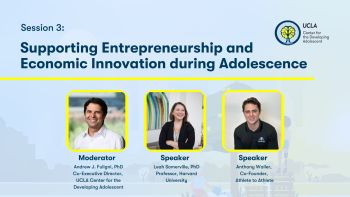“We have studied youth in so many different aspects of psychology for decades, but the world is changing quite dramatically,” said Dr. Mitch Prinstein, at the 2022 American Psychological Association (APA) Science Summit. So, how does the way that we approach the study of youth need to change?
This was the topic of the Future of Science on Youth: 21st Century Developmental Influences panel at the APA Summit, featuring NSCA member Dr. Candice Odgers, UC Irvine, along with Dr. Dante Cicchetti, University of Minnesota and the Institute of Child Development, and Dr. Enrique W. Neblett, University of Michigan School of Public Health.
The panelists identified a few necessary shifts as developmental science looks to the future.
Diversity and intersectionality
“I think we need to (and we are doing so) move beyond a White-centric study of the questions that we have posed in child development and developmental psychopathology,” said Dr. Cicchetti. “It is already beginning to happen in scientific journals, in university departments, and the like.”
Dr. Neblett agreed. “Our world is not just Black/White anymore,” he said. “A number of [new] papers look specifically at how those racial and ethnic identities interact with gender identity, interact with age, for example, in ways that we just haven’t done before.”
Contexts and structural factors
Dr. Neblett shared two ways that his research has changed over the past 2 to 3 years. First, his research on how racism and discrimination can affect our biological systems is beginning to further explore how structural- and institutional-level factors contribute to youth outcomes.
“Instead of just focusing on individual racism or discrimination, we’re looking at the extent to which all of the structural forms of racism have impacts,” he said. “We also have to think about things like incarceration and immigration policy, and how those things also have implications for health.”
Dr. Odgers agreed. “We’re seeing those inequalities or those opportunity gaps for kids replicate themselves in online spaces,” she said. She pointed out that youth from lower-income households spend an average of 3 more hours per day online than their higher-income peers, with less access to quality online learning opportunities.
We need to approach the study of youth from not just an individual perspective, but also a structural one, by asking questions like, “How do we close that opportunity gap across all these different structures and settings?”
Involving communities and youth
Dr. Neblett said that partnering with communities when doing research, such as by involving them in creating questions and conducting surveys, has become increasingly important. “I’m very much trying to partner with youth themselves, and partner with communities to come up with the questions that we ask, because I think that’s an important part of the process,” he said.
Engaging youth in science as research collaborators or focus groups can “increase the chances that the things that we build will have impact, scale, and will be authentic and reasonable out in the world,” said Candice.
Hope for the future
Finally, panelists were asked to share their perspective on the future of science on youth in 10 years.
All agreed it was time to eliminate racial achievement gaps and racism. “It’s got to go,” Dr. Chichetti said, to applause.
“I think there’s a lot of hope,” said Candice. “We have the most educated population of young people this country has seen. There are a lot of positive changes, so I’m hoping that we can continue to build on some of that 10 years from now.”

_770_371_80_c1.jpg)

